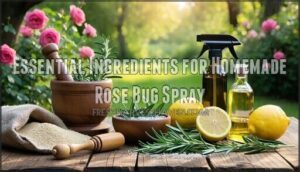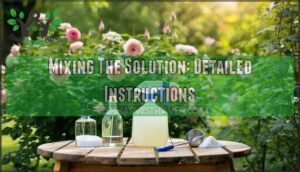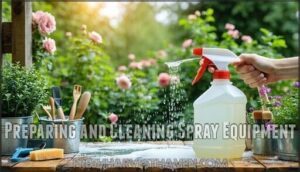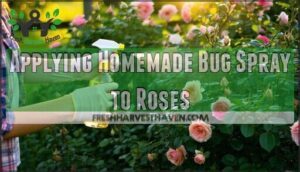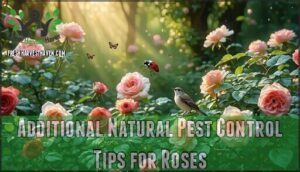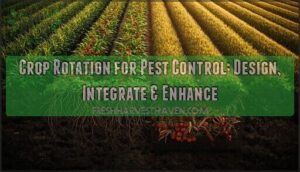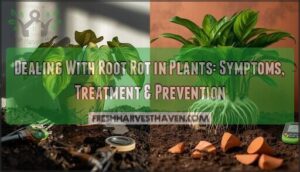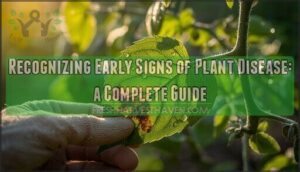This site is supported by our readers. We may earn a commission, at no cost to you, if you purchase through links.
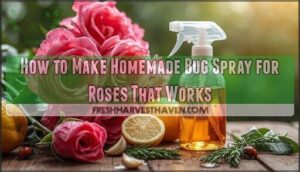
Commercial pesticides promise quick fixes, but sixteen of the thirty most-used lawn products are probable carcinogens.
You don’t need to choose between healthy roses and a safe yard. A homemade bug spray made from kitchen staples costs pennies per gallon and protects your plants without poisoning beneficial insects or putting your family at risk. The solution sits in your pantry right now.
Table Of Contents
Key Takeaways
- A homemade rose bug spray made from vinegar, baking soda, dish soap, and vegetable oil costs pennies per gallon and effectively controls soft-bodied pests like aphids, spider mites, and thrips without harming beneficial insects or posing carcinogen risks like commercial pesticides.
- Apply the spray to leaf undersides every seven to ten days during early morning or evening hours to prevent leaf burn, and reapply immediately after rainstorms or when pest populations surge.
- Combining the homemade spray with companion planting, pest-resistant rose varieties, and regular pruning creates a comprehensive natural defense system that strengthens roses while maintaining garden ecosystem balance.
- The baking soda component alters leaf pH to prevent fungal diseases like powdery mildew and black spot, though it won’t cure severe existing infections without consistent preventive application.
Why Roses Need Safe Bug Control
Roses bring beauty to your garden but they also attract pests that can wreck your plants fast. Chemical sprays work but they’re not always the safest choice for your family or the environment.
Let’s look at why safe bug control matters and what natural options can protect your roses without the risks.
Common Rose Pests and Their Damage
Rose bushes face constant threats from common garden pests that can devastate your blooms. Understanding these enemies helps you choose the right natural pest control strategy:
- Aphids – Cause up to 100% damage during outbreaks, curling leaves and reducing blooms by 40%
- Rose slugs – Remove up to 80% of leaf tissue, creating translucent windows on foliage
- Spider mites – Produce webbing and bronze leaves, increasing plant stress by 25% in dry weather
- Thrips – Create silvery streaks on petals and distort buds, especially when temperatures exceed 95°F
- Japanese beetles – Skeletonize entire leaves within 48 hours during summer feeding frenzies
These rose bugs don’t just spoil appearances. They weaken your plants and invite disease. To effectively manage these pests, it’s vital to learn about pest control methods.
Risks of Chemical Pesticides in Gardens
Chemical pesticides in your garden create serious hazards. Sixteen of the thirty most-used lawn products are probable carcinogens, yet labels often omit this detail. Children face the highest risk—they absorb more chemical toxicity per pound of body weight and experience elevated leukemia rates when parents use conventional pest control.
Chemical pesticides pose hidden dangers—sixteen common lawn products are probable carcinogens, with children facing the highest risk from conventional pest control
Beyond human health threats, these products devastate beneficial insects that provide natural pest control worth $100 billion globally. Over 500 pest species now show resistance, forcing you into an endless cycle of stronger applications while destroying the ecosystem balance that protects your roses naturally. The use of toxic chemicals can lead to environmental hazards that have long-lasting effects on the environment.
Benefits of Organic and Homemade Sprays
Switching to organic sprays lets you protect your roses without gambling on your family’s health or wiping out the beneficial insects your garden needs to thrive. Homemade bug spray costs pennies compared to commercial products and uses kitchen staples you already own.
These DIY pest control solutions give you complete control over what touches your plants—no hidden carcinogens or ecosystem-disrupting chemicals. Natural pest control methods work with your garden’s biology instead of against it, creating lasting green solutions that strengthen rather than weaken your roses.
Essential Ingredients for Homemade Rose Bug Spray
You won’t need a complex lab to make effective rose spray. The recipe relies on common household items that work together to control pests without harsh chemicals.
Here’s what each ingredient does and how to measure it correctly.
Roles of Vinegar, Baking Soda, and Dish Soap
Each ingredient in this homemade spray plays a specific role in protecting your roses from pests and diseases. Vinegar benefits include disrupting pest behavior and adjusting pH balance on leaf surfaces. Baking soda uses involve altering the acidity to inhibit fungal growth and disease.
Dish soap properties act as a natural emulsifier that helps ingredients stick to foliage while breaking down soft-bodied pests.
Using Vegetable Oil as a Surfactant
Vegetable oil acts as the secret handshake between your spray and the leaf surface, making sure every protective ingredient sticks around long enough to do its job.
The surfactant properties of vegetable oil create stable oil emulsions that improve spray adhesion through liquid dynamics. Fatty acid effects help the homemade bug spray coat leaves evenly.
This natural pest control method transforms your DIY pest control solutions into a reliable shield for organic gardening.
Safe Ingredient Proportions for Rose Health
Getting the proportions right matters more than you might think. For healthy roses, mix one tablespoon of vinegar and one tablespoon of dish soap with one and a half tablespoons of baking soda and one tablespoon of vegetable oil per gallon of water. These precise measurements support rose nutrition while maintaining soil quality through organic methods.
The formula provides effective pest control without compromising rose health. This natural pest control approach respects pest tolerance levels while strengthening your organic gardening strategy better than harsh fertilizer types ever could.
Step-by-Step Guide to Making Rose Bug Spray
Making your own rose bug spray is easier than you might think. You’ll need just a few simple steps to mix the solution and prepare your equipment.
Here’s how to create an effective spray that keeps your roses healthy without harsh chemicals.
Mixing The Solution: Detailed Instructions
The key to an effective homemade rose spray is getting your proportions right and mixing the ingredients in the proper sequence.
Start by combining one tablespoon of white vinegar with one cup of water in a clean container. Add one and a half tablespoons of baking soda and stir gently until dissolved. Mix in one tablespoon of dish soap and one tablespoon of vegetable oil. Stir this concentrate thoroughly before adding it to one gallon of water for your final DIY pest control solution.
Preparing and Cleaning Spray Equipment
Your spray equipment needs to be spotless before you mix your first batch—residue from old solutions can sabotage your entire pest control effort.
Wash your spray bottle and gallon jug with hot soapy water after each use. Rinse thoroughly to remove any soap residue. Pay special attention to the spray nozzle where buildup commonly occurs.
Clean equipment ensures your homemade bug spray works effectively and prevents contamination that could harm your roses.
Safe Storage and Handling Tips
Store your homemade rose spray in a cool, dark place—heat and sunlight break down the active ingredients and turn your pest fighter into plain water. Shake well before each use since the vegetable oil separates naturally.
Label your containers with the mixture date and ingredients. This DIY pest control solution stays effective for one growing season. Keep it away from children and pets as a safe gardening practice.
Applying Homemade Bug Spray to Roses
Making your bug spray is only half the battle. The real results come from applying it correctly to your rose foliage.
Let’s cover the best techniques for getting this homemade solution onto your plants where it can actually do its job.
Best Practices for Foliage Application
Applying your homemade spray correctly makes all the difference between protecting your roses and wasting time on ineffective treatments. Focus your spray application techniques on the undersides of rose leaves where pests like aphids hide.
Cover all foliage thoroughly but avoid drenching to the point of runoff. Apply during early morning or evening when temperatures are cooler to prevent leaf burn from the solution.
Optimal Frequency and Timing for Spraying
Once coverage is solid, spray schedules matter just as much. Reapply your homemade bug spray every seven to ten days during active growth periods for effective natural pest control.
Start spraying when roses first push out tender burgundy-tinted foliage—that’s your signal to begin pest monitoring. Time applications for early morning to prevent leaf burn and optimize uptake.
Frequency adjustment becomes necessary when pest pressure increases; you may need treatments twice weekly until populations drop.
Adapting Application After Rain or Infestation
Weather throws curveballs that wash away your careful work, so knowing when to reapply after storms keeps protection consistent. Check foliage within 24 hours after a rainstorm and reapply homemade bug spray immediately if you notice:
- Water droplets beading off leaves instead of absorbing
- Yellowing leaf margins showing pest infestation damage
- Aphid clusters returning to fresh growth tips
- Spider mite webbing appearing on undersides
- Black spot lesions spreading despite previous treatments
Heavy rainfall adjustment means treating again regardless of your seven-day schedule. During pest infestation outbreaks, increase spray frequency to every three days until natural pest control takes hold.
Additional Natural Pest Control Tips for Roses
Your homemade spray works well, but it’s not the only weapon in your pest-fighting arsenal.
A few other natural methods can boost your rose defense and keep bugs at bay without harsh chemicals. Let’s look at some practical strategies that complement your spray routine.
Garlic, Peppermint, and Neem Oil Sprays
Beyond the basic vinegar-and-soap blend, garlic, peppermint, and neem oil sprays give you three more natural weapons against rose pests.
Garlic repels aphids and spider mites with its pungent compounds. Peppermint essential oil disrupts feeding patterns in soft-bodied insects. Neem oil stops aphids and greenflies from reproducing and feeding.
These botanical sprays work as herbal remedies that fit naturally into organic gardening and pest control methods.
Companion Planting and Attracting Beneficial Insects
You can arm your roses with insect bodyguards by choosing the right plant neighbors and rolling out the welcome mat for helpful bugs. Try these methods for attracting beneficial insects and natural pest control:
- Plant marigolds, lavender, and yarrow around roses as companion planting to draw ladybugs and lacewings.
- Set up insect hotels near rose beds to shelter beneficial bugs year-round.
- Add pollinator plants like coneflowers and bee balm for garden diversity.
- Leave small water sources for predatory wasps and hoverflies.
- Skip broad-spectrum pesticides to maintain ecological balance in your organic gardening space.
Pruning and Maintenance for Pest Prevention
Regular pruning cuts off disease before it spreads and keeps air flowing through your rose bushes to discourage pests from setting up camp. Remove dead canes and damaged leaves weekly during the growing season as part of your pruning roses routine. Sterilize your pruning shears between cuts with rubbing alcohol for proper rose sanitation.
Check stems and leaf undersides for early pest monitoring signs like webbing or discoloration. Healthy soil feeds strong roots that resist attacks naturally.
Choosing Pest-Resistant Rose Varieties
Smart rose breeding has given us varieties that fight off pests naturally. Choosing disease-resistant types like Knock Out or Oso Easy Double Red reduces your need for sprays from the start. These roses manage common threats through strong genetics while blooming continuously.
Consider these proven performers for sustainable gardening:
- Home Run Shrub Rose – complete powdery mildew resistance
- Rosa carolina and Rosa virginiana – minimal rose rosette disease symptoms
- New Dawn climber – durable against black spot and mildew
- Rainbow’s End Miniature – tolerates black spot while blooming nonstop
Research shows only 10% of cultivars resist both black spot and cercospora effectively long-term. Native species thrive in poor soil with less water, making pest management easier in your rose garden maintenance routine. Disease resistance traits save you $10 to $15 per plant in reduced pest control costs over time.
Frequently Asked Questions (FAQs)
Can homemade rose spray harm beneficial pollinators?
Dish soap in natural pest control formulations can affect beneficial insects and pollinators like bees if sprayed directly on them.
Apply homemade bug spray in early morning or evening when pollinators aren’t active to maintain eco balance and protect bee-friendly gardens.
How long does homemade bug spray last?
Once mixed, homemade bug spray maintains shelf life for one growing season when stored properly. Fresh batches offer peak spray stability and effectiveness.
Storage tips include using clean containers and keeping solutions in cool, dark locations between applications.
What pests does this spray work against?
This mixture targets soft-bodied pests like aphids, spider mites, thrips, greenflies, and whiteflies.
It also helps prevent fungal diseases on rose foliage.
Effectiveness varies based on pest resistance and infestation severity.
Can I use this spray on buds?
Apply this spray carefully to rose buds for bud protection and blossom health. The gentle homemade bug spray won’t harm developing flowers when used for natural pest control.
Focus on thorough petal care and spray safety to preserve flower quality while maintaining effective organic gardening practices.
Does homemade spray work on fungal diseases?
Yes, but with limits. The baking soda in this recipe alters leaf pH, which helps prevent fungal diseases like powdery mildew and black spot. It won’t cure severe infections, though.
For best disease prevention, spray every seven to ten days and choose naturally resistant rose varieties.
Conclusion
Think of your garden as a living fortress where every rose deserves protection without collateral damage. Your homemade bug spray for roses delivers exactly that—a barrier built from kitchen staples that costs pennies but performs like the premium solutions lining nursery shelves.
You’ve learned the recipes, mastered the timing, and discovered how simple ingredients transform into powerful pest control. Now your roses can flourish while beneficial insects continue their work undisturbed. The choice between beauty and safety was always a false one.

